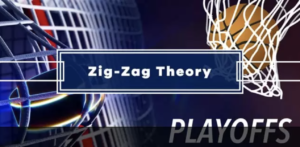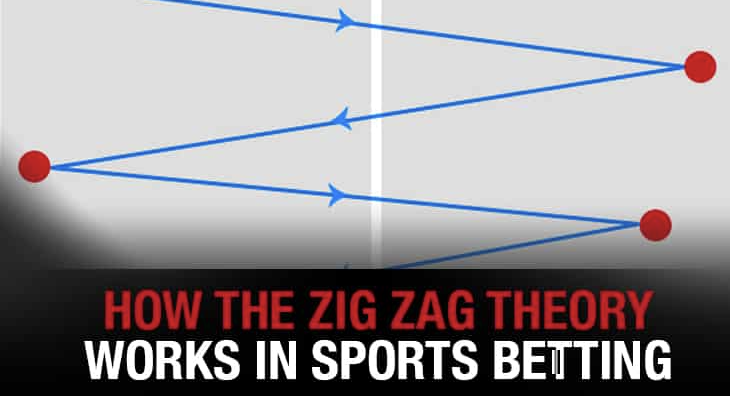The zig-zag theory is a well-known betting strategy used for almost four decades. It is based on the idea that teams, after experiencing a loss, often feel a sense of desperation and are more likely to bounce back and win the next game or series.
According to the theory, if you bet on the team that just lost, you have a higher chance (over 50%) of winning the next game. The odds for the team that suffered the loss are usually more favorable for experienced bettors.
 In a 7-game series, momentum tends to shift back and forth between teams, and the zig-zag theory is a popular method handicapper use to take advantage of these momentum swings. By understanding and utilizing this theory, bettors can make informed decisions regarding moneyline and against-the-spread (ATS) bets.
In a 7-game series, momentum tends to shift back and forth between teams, and the zig-zag theory is a popular method handicapper use to take advantage of these momentum swings. By understanding and utilizing this theory, bettors can make informed decisions regarding moneyline and against-the-spread (ATS) bets.
Where Does the Zig-Zag Theory Come From?
Tony Salinas, a renowned sports handicapper, created the zig-zag theory. Salinas initially developed this theory for application in the NBA playoffs, but it was later found to apply to the NHL as well. Salinas believed that oddsmakers often overlooked the impact of the preceding game when setting their lines for matches within a series, instead placing excessive emphasis on factors like home-court advantage.
Salinas observed that the momentum shift resulting from a team’s loss in the previous game could significantly influence the outcome of the next round. This insight led to the development of the zig-zag theory, which suggests that betting on the team that lost the previous game provides an advantage due to the anticipated rebound in performance. Other experienced bettors, commonly referred to as “sharps,” recognized the validity of this principle and began applying it to both NBA and NHL games.
How Does the Zig-Zag Theory Function on Paper?
The zig-zag theory is designed to be applied to series with a 2-2-1-1-1 format commonly used in the NBA and NHL playoffs. In the past, the NBA finals had a 2-3-1-1 setup, but it was changed back to the original 2-2-1-1-1 structure in 2013 due to concerns about the advantage given to the lower-seeded team.
While some variations of the zig-zag theory are applied to the NFL and MLB, it is generally considered less relevant in these sports compared to the NBA and NHL. This is because the specific structure of the 2-2-1-1-1 series format is integral to the effectiveness of the theory. Outside of this context, the zig-zag theory may yield a different level of efficacy in predicting outcomes.
The Zig Zag Theory and NBA Playoffs
 The zig-zag theory can be applied to NBA playoffs, where home-court advantage is a significant factor. Historically, NBA home teams have a higher winning percentage (64.5%) than the NHL (55.3%). This often leads to highly favored betting lines for the home team, particularly if they win Game 1 of the series. However, statistics show that road teams who lose the first game still win Game 2 slightly over 34% of the time.
The zig-zag theory can be applied to NBA playoffs, where home-court advantage is a significant factor. Historically, NBA home teams have a higher winning percentage (64.5%) than the NHL (55.3%). This often leads to highly favored betting lines for the home team, particularly if they win Game 1 of the series. However, statistics show that road teams who lose the first game still win Game 2 slightly over 34% of the time.
Although the home team is likelier to win Game 2, this increases the value for bettors. A 34%-win rate is not insignificant and presents a substantial opportunity for betting on an outcome that occurs more than one-third of the time.
The odds of the road team winning Game 2 likely imply a significantly lower probability than 34%. This is due to a historical tendency to overreact to a single-game loss. Even if the road team suffers a stern and embarrassing defeat in the previous game, it doesn’t necessarily mean their chances of winning Game 2 are entirely diminished.
Zig-Zag Theory Statistics
Let’s examine some aggregated statistics that demonstrate teams rebounding from losses in the NBA playoffs, which align with the principles of the zig-zag theory.
- If the road team pulls off an upset and wins Game 1 against the home court favorite 76% of the time, the home team will bounce back and win Game 2. So, an early upset should not be misleading.
- In Game 2s, regardless of the specific matchup, the team that lost the previous game covers the spread 56% of the time in their next match.
- When the home favorite has a 2-0 lead and performs Game 3 on the road, the lower-seeded underdog performs well when returning to their home court. Historically, they have a 65% winning rate in the moneyline market and a 68% winning percentage against the spread. Both outcomes occur approximately two-thirds of the time, which is quite significant.
- Favored teams who lost their last game by four points or more will likely triumph against the spread in their next match. The record for couples in this situation is 98-69, equating to a 58.7% winning percentage.
While these statistics provide a valuable starting point, it is essential to consider the context and evaluate each line individually. The zig-zag theory should always be used in conjunction with your analysis to determine if there is value in a particular betting line during the NBA playoffs.
The Zig-Zag Theory and NHL Betting
 Regarding NHL betting, the zig-zag theory can effectively apply when betting on a team to avoid a sweep.In the NHL playoffs, it is more common for a team trying to avoid being swept to win Game 4 rather than getting cleaned thoroughly. Since the NHL lockout in 2005, teams in a 0-3 deficit have managed to win 26 out of 45 games, resulting in a 57.8% winning percentage.
Regarding NHL betting, the zig-zag theory can effectively apply when betting on a team to avoid a sweep.In the NHL playoffs, it is more common for a team trying to avoid being swept to win Game 4 rather than getting cleaned thoroughly. Since the NHL lockout in 2005, teams in a 0-3 deficit have managed to win 26 out of 45 games, resulting in a 57.8% winning percentage.
When analyzing the teams in a 0-3 hole, those playing Game 4 at home have recorded a 16-12 record (57.1% winning percentage), while teams in the same position playing on the road have gone 10-7 (58.8% winning percentage).
It is important to note that the team attempting the sweep is likely to be heavily favored by online hockey betting sites. Although bookmakers consider relevant statistics, they adjust the lines to generate a balanced betting volume. It may be challenging to envision a team that has lost three consecutive matches successfully regrouping.
However, it is crucial to recognize the determination and capabilities of a desperate hockey team facing elimination. Many bettors overlook the underlying statistics of sweeps, leading them to bet on the team that has won the previous three games. Taking advantage of the zig-zag theory in this scenario can present valuable betting opportunities.
The Zig-Zag Theory Is Just a Piece of the Puzzle
It is important not to rely solely on the zig-zag theory and consider it as the only strategy for sports betting. Instead, using your sports knowledge and expertise to form your judgments and conclusions about a team’s chances is recommended.
Staying informed about the latest sports statistics, injury updates, and coaching adjustments is crucial in making well-informed bets. Each playoff series and game within a series is unique, influenced by both tangible factors and intangible elements. Additionally, luck can play a significant role in sports outcomes.
Like any other sports betting strategy, the zig-zag theory should be seen as just one tool in your betting repertoire. There is no guaranteed method to be a successful bettor. Achieving success in sports betting requires hard work, thorough research, experience, and a deep understanding of the sport.
